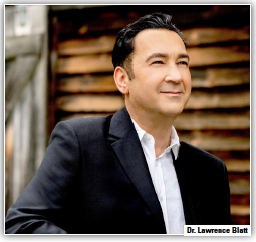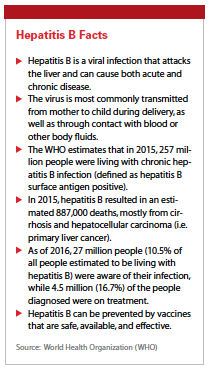A Potential Cure for Hepatitis B
Dr. Lawrence Blatt, CEO, Aligos Therapeutics, discusses his company’s research around antisense oligonucleotides as potential therapies for chronic hepatitis B and other diseases of the liver.
 Despite an available vaccine, the incidence of chronic hepatitis B (HBV) remains high — the largest prevalence of any chronic virus that causes morbidity and mortality — in some regions. These at-risk patient populations face dramatically elevated threats of severe liver diseases, including cirrhosis and hepatocellular carcinoma (HCC), a type of liver cancer in which the five-year survival rate is below 50%.
Despite an available vaccine, the incidence of chronic hepatitis B (HBV) remains high — the largest prevalence of any chronic virus that causes morbidity and mortality — in some regions. These at-risk patient populations face dramatically elevated threats of severe liver diseases, including cirrhosis and hepatocellular carcinoma (HCC), a type of liver cancer in which the five-year survival rate is below 50%.
The only cure is a liver transplant, but liver transplants are difficult procedures and there aren’t enough livers for every hepatitis B patient.
At least 250 million people worldwide carry the virus for chronic hepatitis. Vaccines can stop adults from contracting HBV, but babies are born with HBV each day. Mother-to-child transmission is the most common route in areas with high infection rates.
Aligos Therapeutics is developing a three-pronged approach to develop a functional cure for chronic hepatitis B. A functional cure would mean that certain signs of HBV infection are undetectable or at such low levels in the body, that a patient’s risk of complications from the virus, such as cirrhosis and liver cancer, would be greatly reduced or close to none.
"We know from natural history studies that our approach results in better survival rates and long-term prognosis for those patients," says Lawrence Blatt, Ph.D., CEO, Aligos. “Over time as the HBV virus replicates, it causes liver damage. That damage results in two things. One is a wound healing response that’s incomplete and two patients form cirrhosis, which can lead to end-stage liver disease and liver failure. The only option at that point is a liver transplant."
Aligos is working to knock down specific viral-encoded proteins to address HBV. The hepatitis B virus, like all viruses, has a genome that directs the transcription and translation of viral proteins. For the hepatitis B virus, an important protein is the HBV S-antigen, Dr. Blatt says.
“The surface antigen is important as an immunomodifier, meaning it’s a protein made by the virus that changes the host’s immune system," he says. “It dampens the host’s innate immune response.  Normally, with a virus infection the immune system innately recognizes certain pattern sequences and induces cytokines to counter the virus."
Normally, with a virus infection the immune system innately recognizes certain pattern sequences and induces cytokines to counter the virus."
Aligos’ strategy to achieve a functional cure for HBV is to use a combination of multiple, highly effective therapeutics with unique MOAs and additive/synergistic effects. This strategy has been effective in the treatment of other chronic viral diseases such as chronic hepatitis C and human immunodeficiency virus (HIV). Aligos is employing three complimentary mechanisms — capsid assembly modulators (CAMs), S-antigen transport-inhibiting oligonucleotide polymers (STOPS), and antisense oligonucleotides (ASOs) — with or without standard-of-care chronic hepatitis B treatments.
CAMs, also known as hepatitis B virus (HBV) core inhibitors, are small molecule allosteric inhibitors that interfere with the formation of intact, i.e., infectious, HBV particles. STOPS, closely related to nucleic acid polymers, are oligonucleotides that work via an as yet undefined mechanism of action that results in profound inhibition of hepatitis B surface antigen (HBsAg) formation in vitro and in chronic hepatitis B clinical trials. ASOs are oligonucleotides that bind to complementary mRNAs and trigger their degradation via the enzyme Ribonuclease H, which then can be used to target viral mRNAs such as those encoding the HBsAg protein to lower HBsAg levels and enable reconstitution of the host immune system against the virus.
“We’re specifically targeting hepatitis B in this very selective way," Dr. Blatt says. “By eliminating anything that binds to the human RNA, we then have very good selectivity."
Aligos has two programs going into clinical development that are undergoing IND-enabling toxicology testing. Dr. Blatt says the STOP program will be in the clinic in the middle of the second quarter of this year, and the ASO program is expected to be in clinic by the fourth quarter of 2020. (PV)
~~~~~~~~~~~~~~~~~~~~~~~~~
Hepatitis B Facts
Hepatitis B is a viral infection that attacks the liver and can cause both acute and chronic disease.
The virus is most commonly transmitted from mother to child during delivery, as well as through contact with blood or other body fluids.
The WHO estimates that in 2015, 257 million people were living with chronic hepatitis B infection (defined as hepatitis B surface antigen positive).
In 2015, hepatitis B resulted in an estimated 887,000 deaths, mostly from cirrhosis and hepatocellular carcinoma (i.e. primary liver cancer).
As of 2016, 27 million people (10.5% of all people estimated to be living with hepatitis B) were aware of their infection, while 4.5 million (16.7%) of the people diagnosed were on treatment.
Hepatitis B can be prevented by vaccines that are safe, available, and effective.
Source: World Health Organization (WHO)











